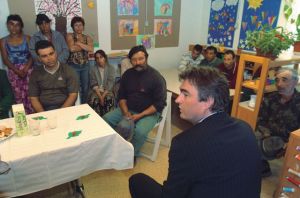Introduction of Separate Classes for Roma in Elementary School Bršljin
After an incident in which a group of Romani parents attacked a teacher in Elementary School in Bršljin, a protest of parents of non-Romani children was organised, threatening with a boycott unless the school separates Roma pupils from others or move part of them to other schools in the area. There were 86 Romani pupils enrolled in the school with 626 pupils. As a solution to the tensed situation, the Slovenian Ministry of Education decided to create special separate classes at the school in certain subjects for Romani children only. Following appeals by parents of Romani pupils, experts and non-governmental organizations (NGOs), the Minister of Education retracted his initial proposal and reportedly suggested that different classes could be created on the basis of the pupils’ knowledge and performance in school. Separate groups in three subjects – Slovene, foreign languages and mathematics – are formed for pupils who do not perform sufficiently well. These special groups have been intended to provide further help to pupils who experience difficulties in the three subjects and, at least in theory, would allow pupils to return to the mainstream groups after a “catching-up” period. Teachers in Bršljin admit that such groups are composed mostly, and in some cases only, of Romani pupils. Such a model has been criticized in Slovenia for being in effect a continuation of the old segregation approach. In a report published in 2006, the Council of Europe expressed concern that the Bršljin model was a step back from the already achieved levels of integration and recommended that its implementation should be revised, in consultation with experts on education and Romani representatives. The Bršljin model was evaluated by the Slovenian education authorities; the evaluation, presented in March 2009 announced some positive results of the model. At the same time the Minister of Education claimed it was the “intervention model” which should be replaced by a new model which is being prepared by the ministry in consultation with experts and schools.
Amnesty International, 16.11.2006, http://www.amnestytv.ca/resource_centre/news/view.php?load=arcview&article=3795&c=Resource+Centre+News, Date of access: 26.10.2011.
MMC-RTV Slovenija, 1.4.2005, http://www.rtvslo.si/slovenija/pilotni-model-pouka-v-brsljinu-bo/34300, Date of access: 26.10.2011.
Mladina, 17.4.2005, http://www.mladina.si/tednik/200515/clanek/slo--romi-ksenija_hahonina/, Date of access: 26.10.2011.
Photo: Minister of Education talks to Roma parents explaining the model of separate classes. Photo by Denis Sarkić, Mladina, 15/2005, http://www.mladina.si/tednik/200515/clanek/slo--romi-ksenija_hahonina/, Date of access: 26.10.2011.

